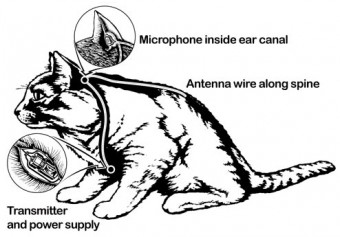The CIA Once Tried Using Cats As Spies
Note: This is a guest article contributed by frequent TIFO visitor and owner of Demotivating Posters, Jon.

Today I found out that in the 1960s, the CIA spent 5 years and over $20 million training spy cats.
I guess it’s not as strange as it might first seem. Cats are stealthy, smart, fast, can jump tall objects, and most people when they see a cat will pet it, not assume it’s a spy. For these reasons the CIA put a 3/4 inch transmitter in a female grey and white cat. They then hid a microphone in its ear canal and had the antenna run along its back all the way to the tip of its tail. However, since cats are relatively small in size, the batteries that were used were small and could only record short conversations. It took some time to get each component just right. Making sure the cat had full mobility and didn’t lick or scratch at the audio devices hidden inside it. The operation was the easy part; the hard part was training the cat to follow directions. As anyone who has ever owned a cat, or been around a cat for any length of time can tell you, getting a cat to do anything other than what it wants to do is nothing short of amazing.
After 5 years of training and $20 million, the CIA felt they could get their special cat agent to move in specific directions and go to specific locations on command (as long as it didn’t get distracted, bored or hungry, which, for a cat, is almost all the time). None-the-less, they decided to field test their $20 million, highly trained acoustic kitty agent. They drove a van across the street from a known Soviet meeting place in Washington, D.C. The targets were two men sitting on a bench in a nearby park. They opened the door and deployed their secret kitty agent. The agent took a few steps and was hit and killed by a passing taxi cab. Needless to say it was a catastrophe (pun intended). The “Acoustic Kitty” project was then scrapped and was called a complete failure. I think the words “catastrophic failure” would’ve been a more appropriate labeling of the project, but that’s just me.
Bonus Factoids:
- In 1953, the CIA and British Intelligence joined together for Operation Gold. It was an operation that involved tunneling under the Soviet Headquarters to listen in on their phone conversations. However, a mole in the British Intelligence tipped off the Soviets before the tunnel was completed. The Soviets went along with it and fed the CIA and British fake information for 3 years.
- During WWII, the military paid behavioral psychologist B.F. Skinner $25,000 to train pigeons to guide missiles to their targets. It involved putting pigeons inside a missile and with a camera on the front of the missile, the bird could see where it was going, on a small screen inside the missile. It would then peck at the screen when the missile would drift off course from where the pigeon was trained to go. However, it was scrapped because government officials just couldn’t get passed the ridiculousness of it.
- In 1962, a group of scientists wondered what the effects of LSD would be on a fully grown elephant. Warren Thomas, Director of the City Zoo, fired a cartridge-syringe containing 297 milligrams of LSD into Tusko the Elephant’s rump. 297 milligrams is a lot of LSD — about 3000 times the level of a typical human dose. In fact, it remains the largest dose of LSD ever given to a living creature. After a few moments, Tusko, the Elephant, fell over. The team tried for two hours to revive him, with no success. Tusko died. It was concluded, “It appears that the elephant is highly sensitive to the effects of LSD.”
Disclaimer: Guest Articles are written by various people and, while I do my best to make sure they are factual by checking their sources and as well as weighing the plausibility of the thing before allowing them to be posted, I do not guarantee that everything in them is going to be 100% accurate as I myself didn’t do the research for these articles and it’s possible their sources, even if they are reputable, are themselves inaccurate.
